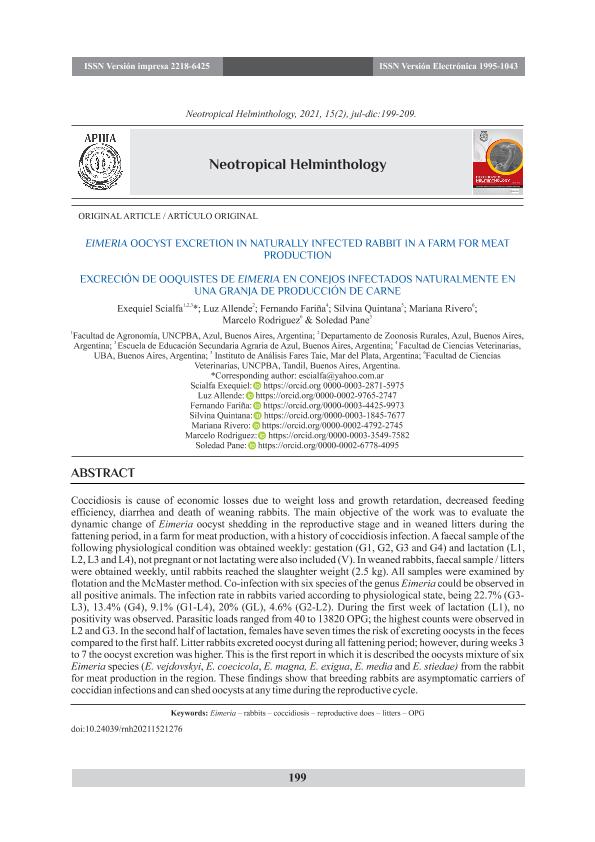Artículo
La coccidiosis es causa de pérdidas económicas debido a pérdida de peso, retraso del crecimiento, disminución de la eficiencia alimentaria, diarrea y muerte de conejos. El objetivo del trabajo fue evaluar la excreción de ooquistes de Eimeriaen hembras reproductoras y sus camadas destetadas durante el período de engorde, en una granja para la producción de carne, con antecedentes de infección por coccidiosis. Se recolectó semanalmente una muestra fecal de las conejas para las siguientes condiciones fisiológicas: gestación (G1, G2, G3 y G4) y lactancia (L1, L2, L3 y L4), también se incluyeron aquellas hembras vacías, es decir que no estaban gestando o lactando (V). En conejos destetados, se recolectaron muestras fecales / camadas / semana, hasta alcanzar el peso de faena. Las muestras se examinaron mediante el método de flotación la cámara McMaster. Se observó co-infección con seis especies del género Eimeriaen todos los animales positivos. La tasa de infección varió según la condición fisiológica de la coneja, siendo 22,7% (G3-L3), 13,4% (G4), 9,1% (G1-L4), 20% (GL), 4,6% (G2-L2). Las cargas parasitarias variaron de 40 a 13820 OPG; los recuentos más altos se observaron en L2 y G3. En la segunda mitad de la lactancia, las hembras tienen siete veces más riesgo de excretar ooquistes en las heces en comparación con la primera mitad. Los conejos excretaron ooquistes durante todo el período de engorde; sin embargo, durante las semanas 3 a 7 la excreción fue mayor. Este es el primer informe en el que se describe la presencia de ooquistes de seis especies de Eimeriaspecies (E. vejdovskyi, E. coecicola, E. magna,E. exigua, E. media andE. stiedae) en conejos de la región. Estos hallazgos muestran que los conejos reproductores son portadores asintomáticos de infecciones por coccidias y pueden arrojar ooquistes en cualquier momento durante el ciclo reproductivo. Coccidiosis is cause of economic losses due to weight loss and growth retardation, decreased feeding efficiency, diarrhea and death of weaning rabbits. The main objective of the work was to evaluate the dynamic change of Eimeria oocyst shedding in the reproductive stage and in weaned litters during the fattening period, in a farm for meat production, with a history of coccidiosis infection. Afaecal sample of the following physiological condition was obtained weekly: gestation (G1, G2, G3 and G4) and lactation (L1, L2, L3 and L4), not pregnant or not lactating were also included (V). In weaned rabbits, faecal sample / litters were obtained weekly, until rabbits reached the slaughter weight (2.5 kg). All samples were examined by flotation and the McMaster method. Co-infection with six species of the genus Eimeria could be observed in all positive animals. The infection rate in rabbits varied according to physiological state, being 22.7% (G3-L3), 13.4% (G4), 9.1% (G1-L4), 20% (GL), 4.6% (G2-L2). During the first week of lactation (L1), nopositivity was observed. Parasitic loads ranged from 40 to 13820 OPG; the highest counts were observed in L2 and G3. In the second half of lactation, females have seven times the risk of excreting oocysts in the feces compared to the first half. Litter rabbits excreted oocyst during all fattening period; however, during weeks 3 to 7 the oocyst excretion was higher. This is the first report in which it is described the oocysts mixture of six Eimeria species (E. vejdovskyi, E. coecicola, E. magna, E. exigua, E. media and E. stiedae) from the rabbit for meat production in the region. These findings show that breeding rabbits are asymptomatic carriers of coccidian infections and can shed oocysts at any time during the reproductive cycle.
Eimeria oocyst excretion in naturally infected rabbit in a farm for meat production
Título:
Excreción de ooquistes de Eimeria en conejos infectados naturalmente en una granja de producción de carne
Scialfa, Exequiel Alejandro; Allende, Luz ; Fariña, Fernando; Quintana, Silvina
; Fariña, Fernando; Quintana, Silvina ; Rivero, Mariana Alejandra
; Rivero, Mariana Alejandra ; Rodriguez, Marcelo; Pane, Soledad
; Rodriguez, Marcelo; Pane, Soledad
 ; Fariña, Fernando; Quintana, Silvina
; Fariña, Fernando; Quintana, Silvina ; Rivero, Mariana Alejandra
; Rivero, Mariana Alejandra ; Rodriguez, Marcelo; Pane, Soledad
; Rodriguez, Marcelo; Pane, Soledad
Fecha de publicación:
12/2021
Editorial:
Asociación Peruana de Helmintología e Invertebrados Afines
Revista:
Neotropical Helminthology
ISSN:
2218-6425
e-ISSN:
1995-1043
Idioma:
Inglés
Tipo de recurso:
Artículo publicado
Clasificación temática:
Resumen
Palabras clave:
EIMERIA
,
REPRODUCTIVE DOES
,
COCCIDIOSIS
,
LITTERS
,
OPG
,
RABBITS
Archivos asociados
Licencia
Identificadores
Colecciones
Articulos (IIPROSAM)
Articulos de INSTITUTO DE INVESTIGACIONES EN PRODUCCION, SANIDAD Y AMBIENTE
Articulos de INSTITUTO DE INVESTIGACIONES EN PRODUCCION, SANIDAD Y AMBIENTE
Citación
Scialfa, Exequiel Alejandro; Allende, Luz; Fariña, Fernando; Quintana, Silvina; Rivero, Mariana Alejandra; et al.; Eimeria oocyst excretion in naturally infected rabbit in a farm for meat production; Asociación Peruana de Helmintología e Invertebrados Afines; Neotropical Helminthology; 15; 2; 12-2021; 199-209
Compartir



